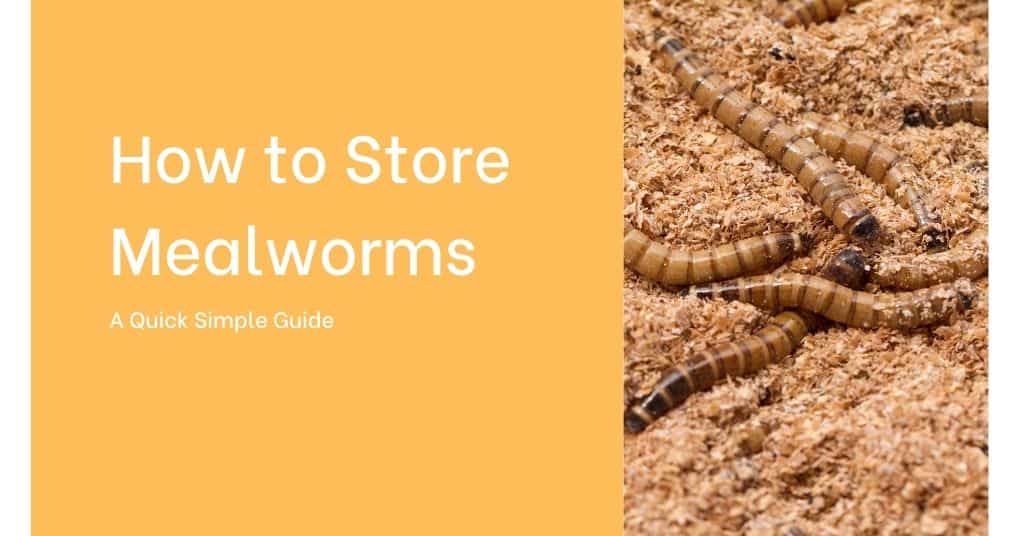
Jeffery Jago is a expert in horticulture and worm breeding. With a background in plant cultivation
Last Updated on May 12, 2021 by Jeffery Jago
Mealworms provide a cost-effective and sustainable food source for pet reptiles, birds, small animals, and fish. When stored properly they can last up to six months or more. This guide will teach you how to store mealworms in the best way possible so that you can enjoy them for years!
The best way to store mealworms
Right off the bat, The best way to store mealworms is to farm them yourself. If you intend to use them for longer periods of time or find yourself using them daily, it’s just best to avoid purchasing them every couple of weeks or months begin with.
Why would you burn so much money on a product you use daily or weekly when mealworms are one of the easiest insects to farm? It just makes sense.
Well, sometimes it’s just not an option for various reasons. That’s ok too, Here’s some more way show to store mealworms.
Storing live mealworms
So aside from breeding them, the best way to store mealworms is to basically set up an entire enclosure that they can live in.
It takes very little effort or preparation to set up, and in fact, you can just outright buy a keeper setup for your mealworms off amazon or something. If you need it now though, here’s what you need to do:
Container: The container should be glass or plastic, and about the size of a shoebox. Don’t use an actual shoebox, they will get through the cardboard.
In general, due to heat dissipation, the bigger the enclosure is, the better. But if you’re only storing a handful of mealworms, don’t go crazy like tossing them into a 40-gallon tank, that’s overkill for sure.
Don’t go too small either. They will just end up suffocating.
Substrate: If you’re just storing your mealworms and have no intentions of breeding them, Simply using any manufactured for mealworm bedding will do just fine. If your goal is simply to keep them alive then theirs no need to go overboard with a high-quality substrate (not to say the ones you can buy aren’t good).
Otherwise, You can mix a bit of cornmeal and oatmeal and other various meals together. Keep it ground up nice and fine, But not too fine where there’s a lot of dust being formed.
As an added option, check out our article on alternative substrates for mealworms.
Food: In the case of most mealworm setups, Their food is their bedding. So make sure to change it out often when it becomes too full of frass (droppings) or just simply get eaten away.
You will need to add occasional vegetables to a single corner of the cage so the mealworms can get its moisture from them. It should be about 1/2 a cup of fresh vegetables. Replace them when they begin to break down too much (24 hours).
If you find your mealworms aren’t getting enough moisture, add a small dish of gelled water. You can find that here. Do not add ordinary water, as it will kill your mealworms which is something you’re trying to avoid! Also don’t leave the gels in for more than 24 hours.
For super long term: If you want to keep them even longer and to halt/slow down their transition into beetle hood even more for a longer-term storage solution, Then stick the entire setup in the fridge. This will slow them down considerably and tack on around 10 weeks to their “worm” stages of survival. After that, they may die or transition to pupa. If that happens you have a chance of breeding them by setting up a breeding container.
Various methods of storing mealworms that aren’t alive
Of course, If your pets aren’t picky if their foods alive or not, You can simply store them as dried-out mealworms. Generally, people already buy them pre-dried, but you can also drive your live orders at home.
- Heat the oven to 200f
- Spread mealworms over the oven (you can freeze them first if you don’t want to put live bugs in your oven)
- Allow to dry for a couple of hours until they’re crispy and fall apart.
Speaking of freezing, that’s another good method. Just toss them onto a baking sheet, freeze for 20 minutes, then dump them in a container and stick it back in the freezer. That makes it easier so they don’t clump up together and you can grab them out individually.
What you shouldn’t do when storing live mealworms
- Put them in cardboard or wood. They’ll climb up the sides and get all over everything, plus they might escape when you open it up to feed your pet!
- Add water to their enclosure
- Cover it too tightly so they suffocate
- Keep it too warm


